![]()
![]()
![]()
Use LEFT and RIGHT arrow keys to navigate between flashcards;
Use UP and DOWN arrow keys to flip the card;
H to show hint;
A reads text to speech;
23 Cards in this Set
- Front
- Back
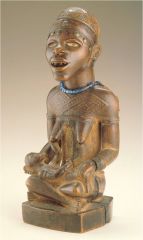
|
Mother and Child, 1850, African Art
chest scarification, jewelry, homage to powerful woman, shows power of women in society MEN/WOMEN, POWER |
|
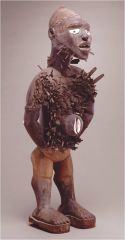
|
Kongo Nail Figure, 1900, African Art
power figurine, very special, one per community meant to solve the problems of the community, hunt down the wrongdoers sort of like a diviner/crystal ball, guarded by one member of community box in center for a substance which and elder would light and then asked for the conflict to be resolved...when it was, would put a nail in sculpture stance=authoritative/open/leaning forward/looks concerned eyes are mirrors, meant to deflect evil white clay around eyes is the heightened awareness mouth open shows communication POWER |
|
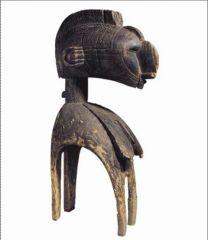
|
Baga Headdress, 1900, African Art
HUGE, men would wear it shows female idols, honors them hair/braids/scarification/distorted nose (vitality) all signs of power/honoring body emphasized, neck breasts (flat, has nurtured children) way to honor mothers |
|

|
Bwa mask, African, 1900
Huge heavy mask, shows flying spirits, heavily patterned each mask honored a spirit checkerboard refers to young age and old age together symbolic, teaches lessons |
|
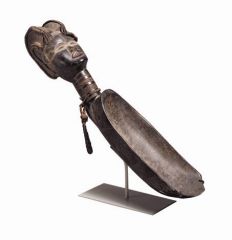
|
Ceremonial Ladle, 1900, African
for a specific woman who was really hospitable, would be passed down, worn out, she would lead the ceremony before harvest has earrings/hairstyle/scarification = POWERFUL WOMAN clay around eyes=heightened awareness |
|
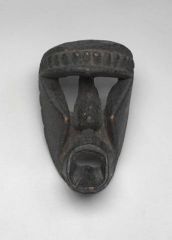
|
Dan mask, African, 1900
mask for men, more like entertainment for tribes, lots of drinking would act like apes, a productive way to express anger etc. shows the boys how NOT to act |
|

|
Modern Kente Cloth, 1970, African
El Anatsui, modern interpretation out of bottle caps, |
|
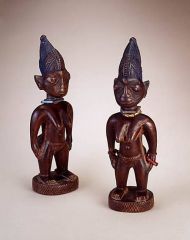
|
Ere Ibeji, African. 1900
twins, believe that twins have high supernatural abilities, joy when twins are born, but lots of complications sculptures like this were made when one of the twins died, to honor him/her were taken care of like humans, ritual feeding/clothing/washing |
|
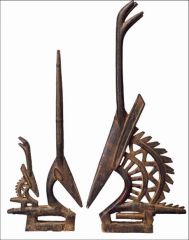
|
Male/Female Antelope headdress, 1900, Africa
Ci Wara=mythical half antelope, half human, introduced farming this was part of ritual to celebrate farming/skills dance with headdress and reenact the original story man antelope has a mane like the sun, woman is lower, smoother like the earth rafia around=water |
|
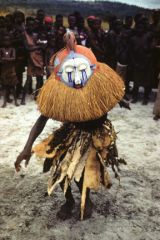
|
Yaka Mask, African 1900
initiation for young boys, transition to manhood wood face and rafia collar, usually a four legged animal on top protecting |
|

|
Bocio Figure, 1900, African
source of protection, would stake them into ground, made by a family member and then blessed by spiritual dude skull of dog on head = loyalty and protection necklace=snake bones, eyes/face=menacing |
|
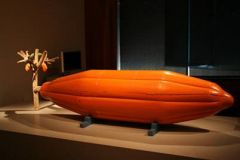
|
Cocoa Pod, 1970, African
Kane Kwei coffin, shape=big part of culture started as a joke but people really wanted them |
|
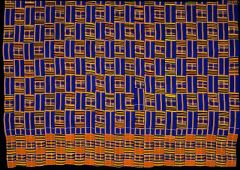
|
Kente Cloth, 1900, African
woven cloth that is cut up in strips and then woven together again, for elite and royalty only, anyone else was punished for wearing it women wore it as two pieces, men as togas |
|
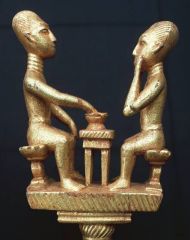
|
Linguist Staff, African, 1900
Power/Leadership, wood with gold foil insignia for rulers linguist=historian, intermediary btwn rulers and people 2 figures talking |
|
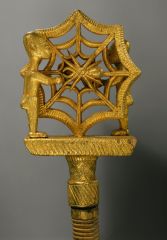
|
Linguist Staff, African, 1900
Power/Leadership, wood with gold foil insignia for rulers linguist=historian, intermediary btwn rulers and people spider=wise, weaving web between 2 peole respected for great oratory skill |
|
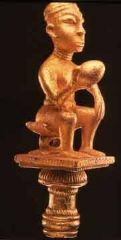
|
Linguist Staff, African, 1900
Power/Leadership, wood with gold foil insignia for rulers linguist=historian, intermediary btwn rulers and people man holding egg: :power is like an egg, when you hold it too tightly it might break, but if you hold it too loose, you might drop it" |
|
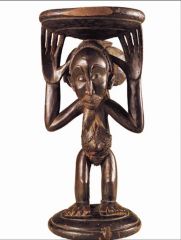
|
Luba Stool, 1900, African
for rulers, metaphorical stool, held their spirit often wrapped in ceremonial cloth, someone had to watch over it woman hold the seat has HUGE hands, shows her job, she is important, says that women are the protection/support for the ruler scarification on stomach, huge forehead (wisdom), long nose (vitality), hairstyle is modern and elite matriarchal society |
|
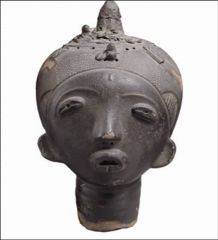
|
Akan Memorial Head, 1900, African
Commemorated deceased individual of high status artist would study subject on death bed, then go home and make sculpture emphasis on eyes, mouth, ears not realistic, but individual |
|
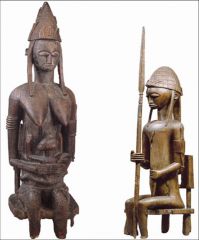
|
Mother and Child, 1800, African
Hard +Heart, shows nurturing but strong, rigid stern but embracing SHOWS IDEAL for community (female) Seated male with Lance, 1900, African "master of strength" was the role of a warrior guarded by old people, then cleaned and oiled and put on display for different occasions SHOWS IDEAL for community (male) |
|

|
Oba on Horseback, 1600, African
Oba= leader in center, lines lead towards him, he has more jewelry/detail/scarification/larger plaque to put on door of ruler, replaced with each ruler |
|

|
Paa Joe workshop, 1970, African
coffins specially made |
|
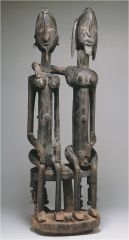
|
Seated Couple, African, 1850
shows gender roles in society, the protective man has a quiver, woman carries a child instead, bodies are very inorganic, segmented, geometric, careful attention paid to space between |
|
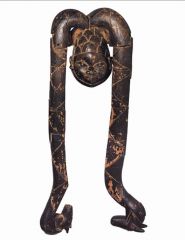
|
Helmut Mask, African, 1900
honors elderly woman, has two elaborate hair snakes eating another animal at the bottom shows chaos and aggression of natural world she is patient and wise though, symbolic of trying to use less violent ways of resolving conflict, advocates diplomacy/peace |

